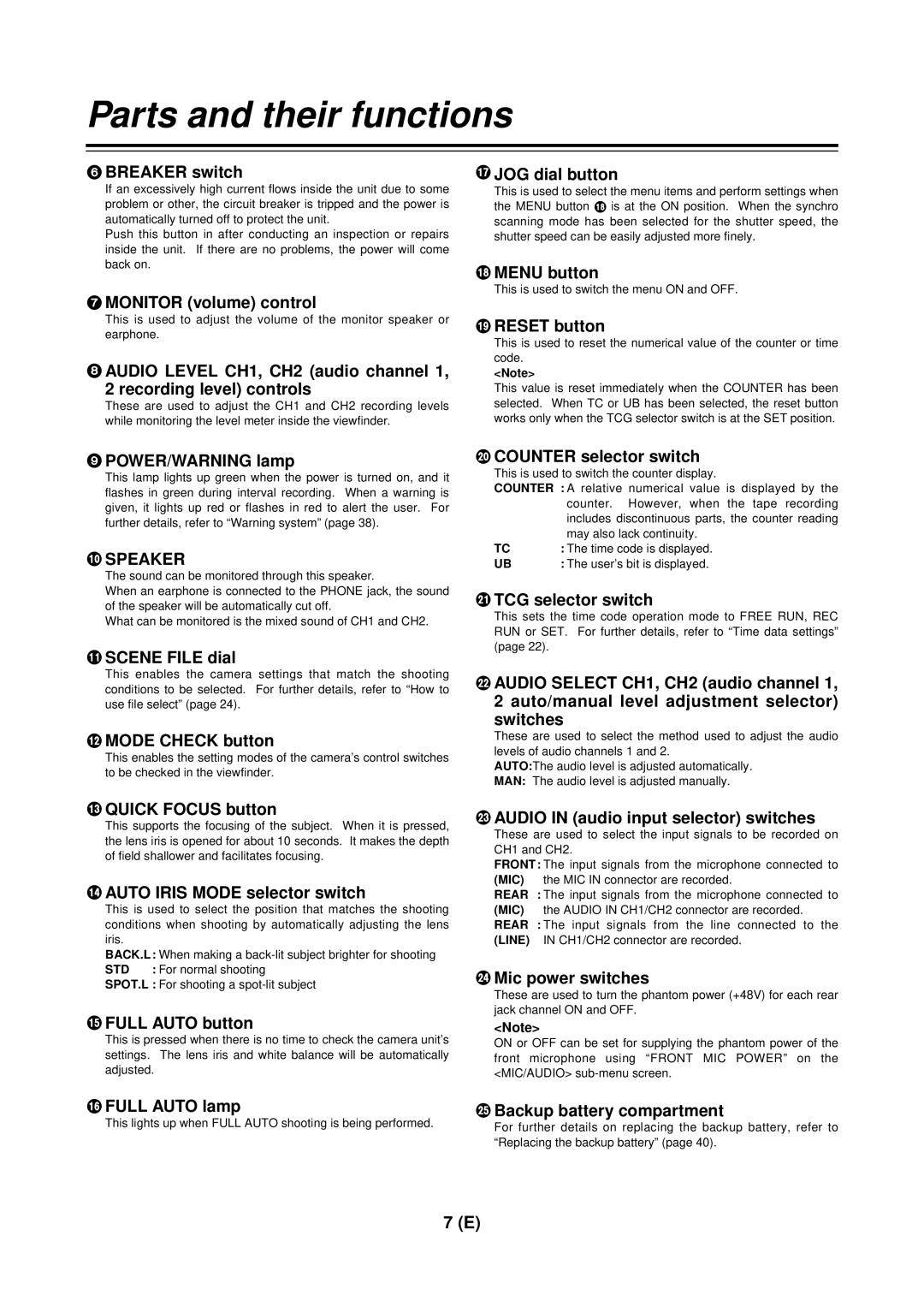Parts and their functions
6BREAKER switch
If an excessively high current flows inside the unit due to some problem or other, the circuit breaker is tripped and the power is automatically turned off to protect the unit.
Push this button in after conducting an inspection or repairs inside the unit. If there are no problems, the power will come back on.
7MONITOR (volume) control
This is used to adjust the volume of the monitor speaker or earphone.
8AUDIO LEVEL CH1, CH2 (audio channel 1,
2 recording level) controls
These are used to adjust the CH1 and CH2 recording levels while monitoring the level meter inside the viewfinder.
AJOG dial button
This is used to select the menu items and perform settings when the MENU button B is at the ON position. When the synchro scanning mode has been selected for the shutter speed, the shutter speed can be easily adjusted more finely.
BMENU button
This is used to switch the menu ON and OFF.
CRESET button
This is used to reset the numerical value of the counter or time code.
<Note>
This value is reset immediately when the COUNTER has been selected. When TC or UB has been selected, the reset button works only when the TCG selector switch is at the SET position.
9POWER/WARNING lamp
This lamp lights up green when the power is turned on, and it flashes in green during interval recording. When a warning is given, it lights up red or flashes in red to alert the user. For further details, refer to “Warning system” (page 38).
:SPEAKER
The sound can be monitored through this speaker.
When an earphone is connected to the PHONE jack, the sound of the speaker will be automatically cut off.
What can be monitored is the mixed sound of CH1 and CH2.
;SCENE FILE dial
This enables the camera settings that match the shooting conditions to be selected. For further details, refer to “How to use file select” (page 24).
<MODE CHECK button
This enables the setting modes of the camera’s control switches to be checked in the viewfinder.
=QUICK FOCUS button
This supports the focusing of the subject. When it is pressed, the lens iris is opened for about 10 seconds. It makes the depth of field shallower and facilitates focusing.
>AUTO IRIS MODE selector switch
This is used to select the position that matches the shooting conditions when shooting by automatically adjusting the lens iris.
BACK.L : When making a
STD : For normal shooting
SPOT.L : For shooting a
?FULL AUTO button
This is pressed when there is no time to check the camera unit’s settings. The lens iris and white balance will be automatically adjusted.
DCOUNTER selector switch
This is used to switch the counter display.
COUNTER : A relative numerical value is displayed by the
| counter. However, when the tape recording |
| includes discontinuous parts, the counter reading |
| may also lack continuity. |
TC | : The time code is displayed. |
UB | : The user’s bit is displayed. |
ETCG selector switch
This sets the time code operation mode to FREE RUN, REC RUN or SET. For further details, refer to “Time data settings” (page 22).
FAUDIO SELECT CH1, CH2 (audio channel 1, 2 auto/manual level adjustment selector)
switches
These are used to select the method used to adjust the audio levels of audio channels 1 and 2.
AUTO:The audio level is adjusted automatically.
MAN: The audio level is adjusted manually.
GAUDIO IN (audio input selector) switches
These are used to select the input signals to be recorded on CH1 and CH2.
FRONT: The input signals from the microphone connected to (MIC) the MIC IN connector are recorded.
REAR : The input signals from the microphone connected to (MIC) the AUDIO IN CH1/CH2 connector are recorded. REAR : The input signals from the line connected to the (LINE) IN CH1/CH2 connector are recorded.
HMic power switches
These are used to turn the phantom power (+48V) for each rear jack channel ON and OFF.
<Note>
ON or OFF can be set for supplying the phantom power of the front microphone using “FRONT MIC POWER” on the <MIC/AUDIO>
@ FULL AUTO lamp | I Backup battery compartment |
This lights up when FULL AUTO shooting is being performed. | For further details on replacing the backup battery, refer to |
| |
| “Replacing the backup battery” (page 40). |
7 (E)
